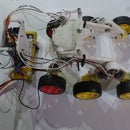Introduction: Brick Forge
I got into blacksmithing recently and my forge design seems somewhat unique so I figured I'd share it. I am currently burning charcoal but it might work with other fuels. It seems to heat metal just fine. The forge does not require cement and is about as simple as they come.
Step 1: Materials
1. At least 8 fire bricks (fire bricks are different than normal brick in that they are more resistant to heat and have more of a clay-like texture)
2. Shop-Vac (or similar appliance) with hose
3. Steel Pipe (length and width don't matter that much as long as it is close to as wide as the vacuum hose and is at least 3ft long to prevent damage to the vacuum)
4. 7ft Wire
5. Duct Tape
Step 2: Lay the Bricks
Start with a base of 1x3x2 bricks if you want it elevated (you will need 6 more bricks for this). the other steps are near impossible to explain so just follow the pictures. I use a broken cinderblock for the lid because it gives me a bit to grab on to however a normal brick would work just fine.
Step 3: Finishing Steps
Duct tape the hose to the pipe. Then prop the pipe up with something (like extra bricks) so that the end is facing the opening on whichever side of the forge that you designate as the back. Wrap the wire around the top 4 bricks and tighten it as much as you can. That's about it. The opening on the top is used to load charcoal/whatever fuel you're using.
Step 4: Suggestions?
I'd love to improve my design so if anyone reading this has any suggestions please post them in the comments section.

Participated in the
Tools Contest













